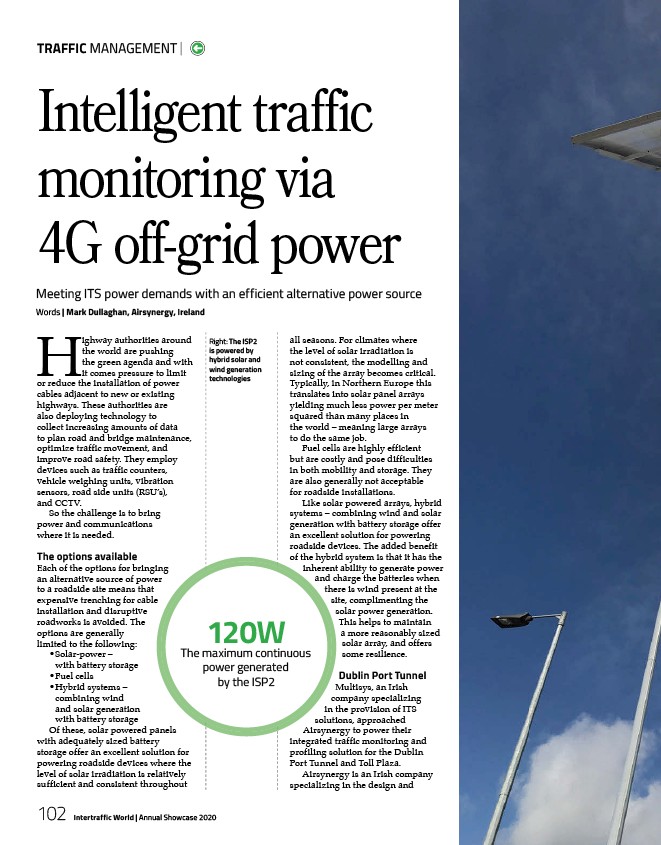
TRAFFIC MANAGEMENT |
Intelligent traffic
monitoring via
4G off-grid power
Meeting ITS power demands with an efficient alternative power source
Words | Mark Dullaghan, Airsynergy, Ireland
Highway authorities around
Right: The ISP2
the world are pushing
is powered by
the green agenda and with
hybrid solar and
it comes pressure to limit
wind generation
technologies or reduce the installation of power
cables adjacent to new or existing
highways. These authorities are
also deploying technology to
collect increasing amounts of data
to plan road and bridge maintenance,
optimize traffic movement, and
improve road safety. They employ
devices such as traffic counters,
vehicle weighing units, vibration
sensors, road side units (RSU’s),
and CCTV.
So the challenge is to bring
power and communications
where it is needed.
The options available
Each of the options for bringing
an alternative source of power
to a roadside site means that
expensive trenching for cable
installation and disruptive
roadworks is avoided. The
options are generally
limited to the following:
• Solar-power –
with battery storage
• Fuel cells
• Hybrid systems –
combining wind
and solar generation
with battery storage
Of these, solar powered panels
with adequately sized battery
storage offer an excellent solution for
powering roadside devices where the
level of solar irradiation is relatively
sufficient and consistent throughout
102 Intertraffic World | Annual Showcase 2020
all seasons. For climates where
the level of solar irradiation is
not consistent, the modelling and
sizing of the array becomes critical.
Typically, in Northern Europe this
translates into solar panel arrays
yielding much less power per meter
squared than many places in
the world – meaning large arrays
to do the same job.
Fuel cells are highly efficient
but are costly and pose difficulties
in both mobility and storage. They
are also generally not acceptable
for roadside installations.
Like solar powered arrays, hybrid
systems – combining wind and solar
generation with battery storage offer
an excellent solution for powering
roadside devices. The added benefit
of the hybrid system is that it has the
inherent ability to generate power
and charge the batteries when
there is wind present at the
site, complimenting the
solar power generation.
This helps to maintain
a more reasonably sized
solar array, and offers
some resilience.
Dublin Port Tunnel
Multisys, an Irish
company specializing
in the provision of ITS
solutions, approached
Airsynergy to power their
integrated traffic monitoring and
profiling solution for the Dublin
Port Tunnel and Toll Plaza.
Airsynergy is an Irish company
specializing in the design and
120W The maximum continuous
power generated
by the ISP2